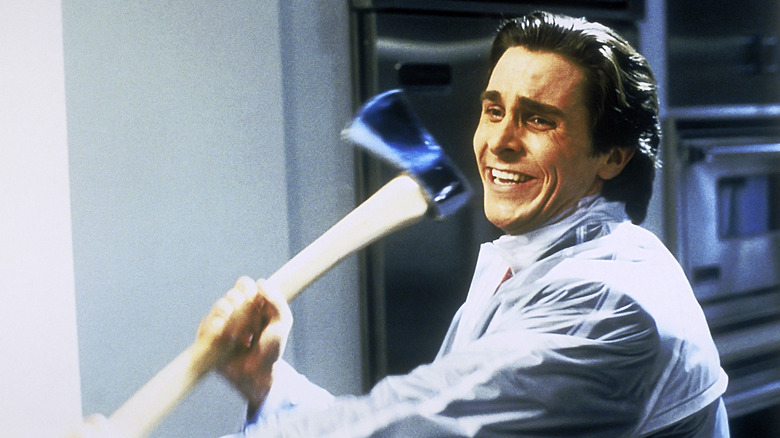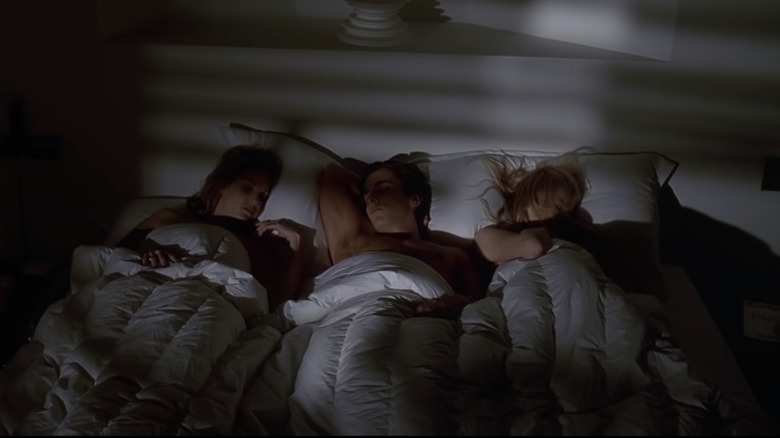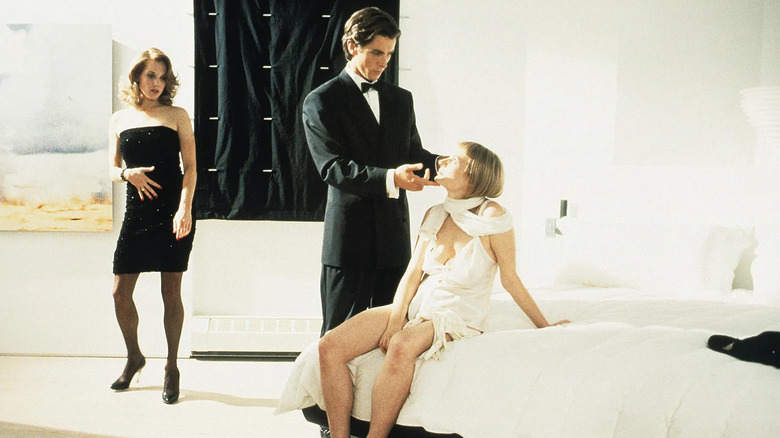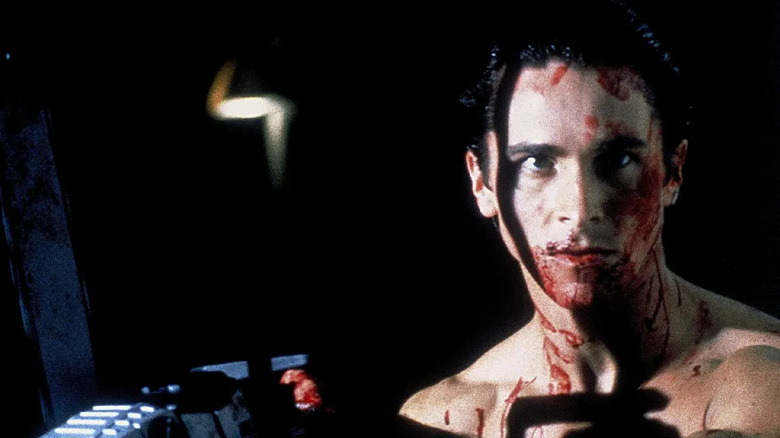American Psycho Had To Make Some Cuts To Dodge The Dreaded NC-17 Rating
22 years after its U.S. release, Mary Harron's "American Psycho" still has a tremendous amount of blunt-force bite. Two decades haven't dulled the film's horrifying impact, particularly because the central character of Patrick Bateman (played by Christian Bale in a career-defining performance) feels so steeped in the very real confines of American masculinity. Though the film, based on Brett Easton Ellis' 1991 novel of the same name, is exceptionally interested in the excessive exploits of the American elite during the 1980s, its depiction of patriarchal ideals and the violence they reap against marginalized groups continues to resonate today. Yet even ahead of the film's release in 2000, the MPAA feared that certain shots were far too salacious to merit an R rating.
As it turns out, the threat of an NC-17 rating wasn't explicitly related to the film's violence and bloodshed, but rather a far more intimate matter. Let's turn back the clock 22 years and see just what made such a stir ahead of the release of "American Psycho" — that is, aside from its focus on a yuppie serial killer living a life of luxury in New York City.
The NC-17 death knell
While the film premiered to positive reviews in its uncut glory at the 2000 edition of the Sundance Film Festival, the MPAA had reservations when it came to giving the film a rating ahead of its U.S. theatrical release. Though British director Mary Harron (who previously directed the 1996 film "I Shot Andy Warhol") was vying for a standard R rating, the MPAA threatened to give the film a dreaded NC-17 rating if it didn't make some specific changes.
Though it's true that many enduringly popular and well-regarded films have proudly flaunted their NC-17 ratings, from Sam Raimi's "The Evil Dead" to Paul Veerhoeven's "Showgirls," it has also historically hindered audience accessibility, damaging a film's ability to succeed at the box office as a result. Some films are so steeped in transgressive violence and sexuality that an NC-17 rating is unavoidable (Larry Clark's "Kids" immediately comes to mind), but most filmmakers will make whatever changes are deemed necessary by the MPAA to secure an R rating (and in turn secure prospective profits).
So, what exactly was Harron tasked with nixing from "American Psycho" in order to guarantee an R rating?
A few seconds in heaven (or is it hell?)
Luckily for Harron, the MPAA only took issue with one specific scene, and with the quick, seamless cuts of a few (seemingly inconsequential) seconds, the R rating was easily secured. The Guardian provided a scoop on this very issue a few months before "American Psycho" landed in U.S. theaters:
"The film had been slapped with a prohibitive NC-17 rating by the Motion Picture Association of America (MPAA) who were concerned over a section in which the tale's serial-killing anti-hero (played by Christian Bale) has sex with two prostitutes. A spokesman for the independent distribution company Lions Gate Entertainment now confirms that "a few seconds" have been cut from the offending section and that the MPAA has now passed the film as an R-rated picture."
The scene in question involves Patrick soliciting a sex worker named Christie (Cara Seymour) to visit his swanky Upper West Side apartment. When she obliges and enters his chauffeured car, he immediately gets on the phone and calls an escort service, demanding that they send over a blonde who is comfortable with handling couples. What ensues is a threesome that mostly serves as an extended monologue for Patrick to examine his personal fanaticism surrounding Phil Collins, though he criticizes Collins' band Genesis' early work as having been "too artsy, too intellectual." Classic Patrick.
In total, what's cut mostly has to do with female nudity and sexual acts: The escort grabbing Christie's butt, Christie's exposed butt crack while she lounges on Patrick's bed, and the awkward fumblings of changing positions mid-threesome were just a few of the small changes eliminated from the theatrical version. Of course, the MPAA would straight-up revolt if a woman's full moon were to brazenly grace the silver screen.
The Wall Street chainsaw massacre
In context, it's kind of hilarious that this particular threesome scene is the one the MPAA took issue with. The trio meet up again later in the film for another sexual foray — but unluckily for them, Patrick's perfect facade has begun to fall away. During an especially frenzied act of sexual foreplay, Christie cautiously begins to gather her clothing to sneak out. Only then does she realize that there's blood on the sheets, and her fellow escort's squeals of pleasure from having Patrick go down on her slowly devolve into cries of pain. Patrick emerges from under the sheet, his mouth covered in blood — his method of cunnilingus having turned cannibalistic. Christie dashes down the hallway in her negligee, throwing open a door only to find the pale corpses of women hanging where coats should be. Sporting only sneakers and a chainsaw, Patrick quickly pursues. Christie finally makes it out of the apartment, wailing and pounding on neighboring apartment doors, but no one emerges to help her; it appears no one else even lives in this building.
As she rushes down the fire exit's steep staircase, Patrick approaches. He stops at the top of the landing, laughing maniacally and waving his weapon. Christie continues her doomed descent, and Patrick perfectly aims his chainsaw to meet her on the way down. This is perhaps one of the most memorable scenes in the entire film, and though it's horrifying and bleak, it's a miracle that the MPAA didn't mess with it — particularly when noting their track record when it comes to censoring female cunnilingus on screen ("Blue Is the Warmest Color" also got an NC-17 rating for that very reason). Perhaps what salvaged "American Psycho" from this same fate is the fact that in the end, Patrick's escort was literally eaten out — an incredibly unsexy turn, erotic only to literal cannibals. Luckily, the uncut version of "American Psycho" is readily available for purchase (in a 4K Blu-ray version, no less). Here's to preserving the sleaze of cinema, even when it's just a few scant, ultimately unsexy seconds.



